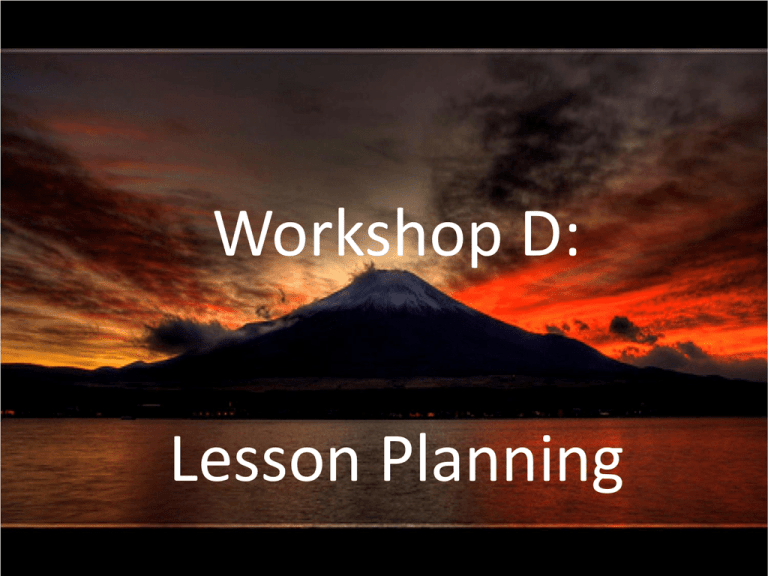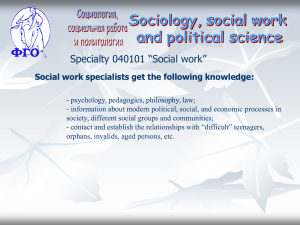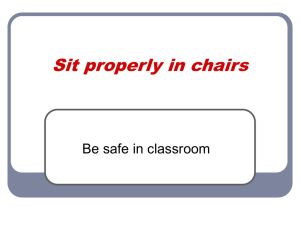Part 1 - EigoBento
advertisement

Workshop D: Lesson Planning Who Am I? • • • • There will be a name on your back. Your goal is to find out who you are. You may only ask Yes/No questions. You have 5 minutes 5:00 4:00 3:00 2:00 1:30 1:00 :30 Time’s Up! What is Lesson Planning? • Detailed directions for your lesson that anyone can follow Choosing Topics vs. Textbook Teaching • You can choose topics as a way to express yourself and share your culture or interests • Textbook lessons don’t have to be boring • Tailor it to yourself, your school and your JTEs Golden English Topics • See if you can find some common themes. • Let’s make a list together. Verbal The 4 Skills Written Receptive Listening Productive Speaking Reading Writing Four skills + English topics Choose a Golden Topic You have 5 minutes to create a lesson with activities that use the four skills Example: Topic: Weather Listening: Listen to a weather report Writing: Fill in dictation while listening to the report Writing: Write reports for certain places Speaking: Give a weather report Reading: Read a weather report Activities that use many skills at once are best! Backward Lesson Planning (pg 12) It’s helpful to know the destination before you start to drive! 1. Course Goal (Broad! Ex: speak English conversationally) 2. Course Objectives (Specific! Ex: order food at a restaurant) 3. Assessment 4. Activities 5. Write your lesson plan Scaffolding (pg 13) A process of breaking units of information into smaller pieces which are easier to process and learn. • Vocabulary • Grammar • Activities Scaffolding • Vocabulary – Easiest and fastest: use a picture – Hardest and most time consuming: give one or more contexts and ask students to guess meaning – Time consuming, but maybe easier: break the word into components Scaffolding • Grammar Example: Passive voice – “Close your eyes. (students close eyes. JTE and ALT rearrange room). Okay open your eyes. What’s different? (a student says ‘chair’). Good! The chair has been moved. Who moved it? (students shrug and guess ALT or JTE). You don’t know or it’s not important. Let’s make a sentence…” • Written on board: The chair has/have ____ (what happened?) • “the chair. Is it one chair or many? Yes. One. One chair ‘has’ or one chair ‘have?’” • “One chair has. Good. What happened? Yes. It moved. One chair has ____ moved. What’s this (pointing to blank? ‘Been. Yes!’ One chair has been moved. What else has changed?... (students make list using this structure) • what? has/have been what happened? Scaffolding Grammar • Note: students may not know most grammar terms (like ‘passive voice’) even in Japanese. They may not even understand their own language rules. Explaining rules and terms can confuse and frustrate them. • Demonstrating the use and structure will make it much easier to grasp. • However, students may be familiar with the simple expression “SVO” (subject – verb – object). • This can be handy when writing out the sentence (presented) to show what each part represents and how it moves. Scaffolding: Actions or activities: • Often, you may find that even simple directions confuse students. • Perhaps they can only grasp a few words at a time or they aren’t expecting to do something. • Break instructions down into bite sized parts when needed. Actions and Activities • Example: turning on a light • “(to student A) What’s that? Yes, a light! Is the light on? No, it’s off. Stand up. Walk. Walk. Walk (bringing student A to the switch). What’s this? It’s a light switch. Is the light on? No. Turn on the light. Good. Turn off the light. Thank you. Please sit down. (to student B) Turn on the light, please. Actions and Activities are always better demonstrated rather than explained. Scaffolding •Why is it important? •It turns something difficult into something easy •Maybe you won’t use our specific examples, but when you are explaining new things, you should explain using things the students know











